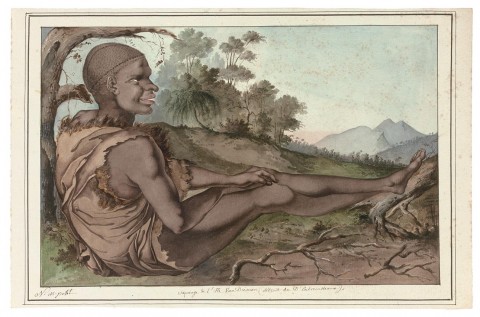SAUVAGE DE L’ÎLE VAN DIEMEN (DÉTROIT DE D’ENTRECASTEAUX), early 1802
NICOLAS-MARTIN PETIT
probably late January or early February
ink, watercolour and gouache on lightly tinted blue laid paper
183 x 278 mm (image within an ink border, within ruled border)
212 x 323 mm (sheet)
signed lower left: N.m. petit
inscribed with title below image: Sauvage de l’Île Van Diemen (détroit de D’Entrecasteaux).
None known
Le Havre holds two pencil and charcoal versions of this portrait, both also by Petit, although only one is reproduced in Bonnemains (see nos. B:20013.1 & 20013.2)
An extremely important work: not only a superb portrait in its own right, this example is one of the rare occasions when Petit included a full landscape in the background, here rendered with the sort of topographical accuracy and well-observed use of colour that marked the famous coastal profiles he painted. Previously known only from a later pencil sketch in Le Havre with no documentation of any kind, the caption to the present work therefore reveals that this is a man from the region of D’Entrecasteaux Channel and, as with the previous two items, is believed to depict a man from the interaction that took place at North West Bay.
Not only is this a fine portrait, it is probably the finest of Petit’s major Tasmanian studies: it is certainly the most fully realised, and also one of the occasions on which he has really mastered the representation of the elongated but still muscular limbs. There is a sense of repose, but also of place, most particularly in the wonderfully accurate juxtaposition of the lush foliage in the middle ground with the blackened trunk on which the man is leaning. The mountain range in the background is rendered so precisely that it may yet prove possible to locate the spot quite accurately: certainly there can be no doubt that this is meant to be part of the ridge of higher ground on the mainland, as the topography of both Bruny and Maria Islands is somewhat gentler. Indeed, that the mainland is depicted here is further suggested by the fact that the man is leaning against a scorched tree trunk (the use of fires by the Tasmanians, and the partially scorched landscape of the mainland, was frequently described by the French).
The man himself is quite beautiful. He has an incredibly strong profile with prominent brow and nose, tightly cropped hair with what would seem to be thin braids as decoration, and long elegant limbs. There is no visible scarification nor ornamentation of any kind (although of course the torso, where this was usually most prominent, is not visible), and he is wearing a very full kangaroo cloak draped over his right shoulder. Indeed, he is so attractive that the only sketch of this man in Le Havre had led to some debate about the sitter’s sex: the nineteenth century curator Hamy thought it showed a man, his twentieth-century colleague Bonnemains a woman. The use of “sauvage” in the caption here (and not “femme sauvage” as with the previous item), would seem to settle the debate.
Apart from a similar but not as fully-realised work depicting a man seated before a fire (B:20005), and the full-length portrait of a boy standing on a beach in front of a heavily-wooded hillside, which also features carefully depicted mountains in the background (B:20021.4), this is only the third full Tasmanian view known to have been executed by Petit, and gives a tangible sense of his talent (and of the sort of work that was unfulfilled because of his early death).
No full portrait of this man was ever published.
